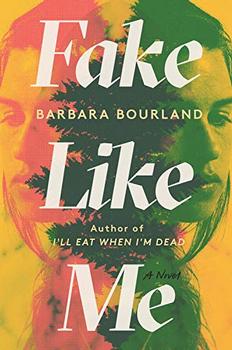Summary | Excerpt | Reading Guide | Reviews | Beyond the Book | Read-Alikes | Genres & Themes | Author Bio

Critics' Opinion:
Readers' Opinion:
First Published:
Jun 2019, 368 pages
Paperback:
Feb 2020, 368 pages
 Book Reviewed by:
Book Reviewed by:
Jamie Chornoby
Buy This Book
This article relates to Fake Like Me
 In Fake Like Me, author Barbara Bourland alludes to artist Lee Lozano (1930-1999) and her elusive, controversial final project called Dropout Piece. This piece of performance art was Lozano's act of withdrawing from the art world in order to be an outsider. She slipped into isolation through the end of her life, pushing the boundaries of lived art, performance art, and conceptual art. Bourland considers Lozano's unusual project, and how her rigorous, defiant act might have influenced artists that came after her.
In Fake Like Me, author Barbara Bourland alludes to artist Lee Lozano (1930-1999) and her elusive, controversial final project called Dropout Piece. This piece of performance art was Lozano's act of withdrawing from the art world in order to be an outsider. She slipped into isolation through the end of her life, pushing the boundaries of lived art, performance art, and conceptual art. Bourland considers Lozano's unusual project, and how her rigorous, defiant act might have influenced artists that came after her.
To understand what inspired Dropout Piece and why it was important to Lozano to remove herself from social spheres, it is necessary to review her short and strange history as an artist. Most of her work was created within the span of a decade. She started off studying at the Art Institute of Chicago, graduating in 1960, and moving to New York City that same year. In the early stages of her career, Lozano's art consisted primarily of hypersexual, cartoonish paintings and drawings. However, by the mid-'60s, she transitioned into abstract expressionist works. Her paintings from this time feature tools—such as screws, pipes and wrenches—colored in muted grays with mechanical lines. Between 1967-1970, Lozano created her final and most popular set of paintings, the eleven-piece Wave series.
Lozano herself was known for being personally confrontational, caustic, outrageous and lurid, but this is equally true of her renegade transition into conceptual art. In the late '60s she began life-art practices, which are tests, activities, experiments and investigations she designed to be lived performance art. She aimed to both probe at society and exempt herself from it. One of the most popular conceptual projects that Lozano undertook was called Boycott Piece or Decide to Boycott Women. It started as a month-long project in 1971 during which Lozano decided to stop communicating with other women; she supposedly hoped to expose gendered power relations, while simultaneously removing herself from those relations. Lozano was so devoted to the project that she continued it for most of her life. Likewise, her General Strike Piece (1969) involved her earliest attempts to withdraw from the New York art establishment "in order to pursue total personal and public revolution," according to her notes.
Dropout Piece (1970-1999) was the culmination and intensification of these acts of removal, called her "pièce de résistance" by Art in America magazine. Essentially, Dropout Piece was Lozano's defiant exit from the art scene and from society as a whole; she gradually seeped into a self-imposed exile. She left New York City, moving outside of Dallas. She stopped attending gallery openings and museum visits; she refused to engage with other artists in public formats. Lozano continued to isolate herself even into her struggle with cervical cancer at the age of 68, so much so that little is known about the artist's life after the early 1970s. She requested an unmarked gravesite upon her death, believed by many to be the final component of Dropout Piece, a total loss of self.
Still, others believe that there is no definitive way to know how long Dropout Piece lasted, or if it existed at all. There is nothing to exhibit in a typical sense—no paintings, drawings, concerts, sculptures, photographs or films. Perhaps Lozano's antics were not artistic but a symptom of mental instability. Art critic Lucy Lippard counters this, asserting the artist's authenticity: "Lee was extraordinarily intense, one of the first, if not the first person who did the life-as-art thing." Regardless of others' opinions, Lozano certainly considered Dropout Piece her final work of art, naming it, taking detailed notes on it and following its parameters for decades. Committed to even her most obscure projects with vigor, Lozano used her art as commentary on her various identities—that of being a woman, an artist and a person.
Lee Lozano courtesy of MIT Press
Filed under Music and the Arts
![]() This "beyond the book article" relates to Fake Like Me. It originally ran in July 2019 and has been updated for the
February 2020 paperback edition.
Go to magazine.
This "beyond the book article" relates to Fake Like Me. It originally ran in July 2019 and has been updated for the
February 2020 paperback edition.
Go to magazine.
Press back arrow to return to articles, or click here.
This review is available to non-members for a limited time. For full access become a member today.




The House on Biscayne Bay
by Chanel Cleeton
As death stalks a gothic mansion in Miami, the lives of two women intertwine as the past and present collide.

The Flower Sisters
by Michelle Collins Anderson
From the new Fannie Flagg of the Ozarks, a richly-woven story of family, forgiveness, and reinvention.

The Funeral Cryer by Wenyan Lu
Debut novelist Wenyan Lu brings us this witty yet profound story about one woman's midlife reawakening in contemporary rural China.
Your guide toexceptional books
BookBrowse seeks out and recommends the best in contemporary fiction and nonfiction—books that not only engage and entertain but also deepen our understanding of ourselves and the world around us.